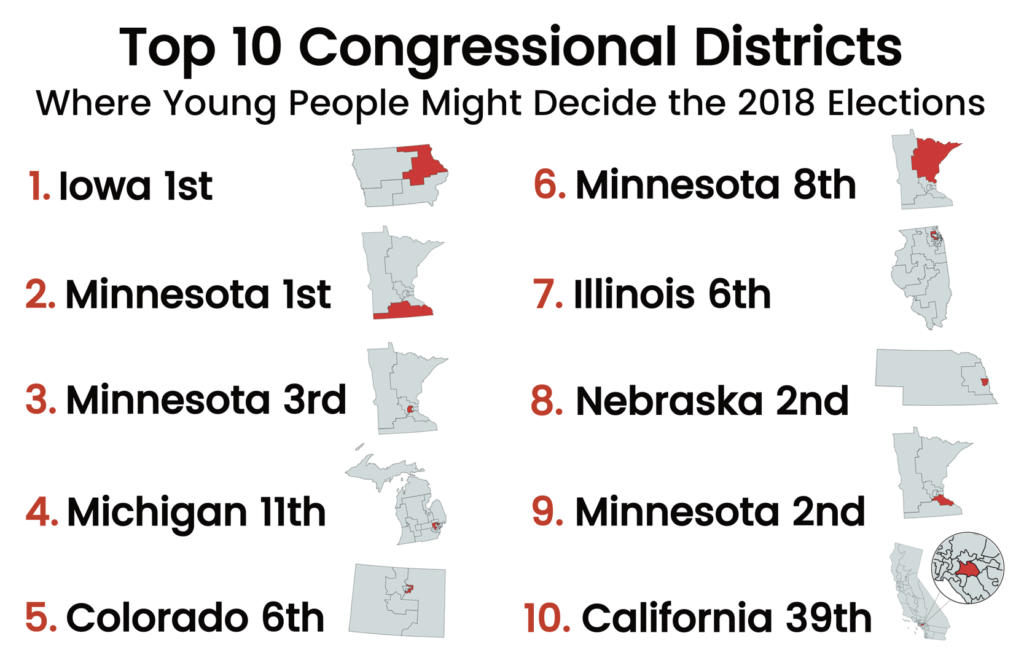Millennial voters are fed up with the way politicians have been dealing with issues like climate change, and now they are fighting back.
Two new studies, released last week, have revealed younger voters ages 18 to 29 have the power to influence ten competitive congressional races in the upcoming U.S. elections - if only they get out and vote.
The first study, from the Pew Research Center, has shown millennials are far more liberal than their parents on issues like climate change and they are much more likely to vote for Democratic candidates.
The survey reveals millennials are the only generation in which a majority 57 percent have consistently liberal (25 percent) or mostly liberal (32 percent) political leanings. In comparison, just 12 percent have consistently or mostly conservative attitudes, which is the lowest of any generation.
"Generational differences have long been a factor in U.S. politics," the study reads.
"These divisions are now as wide as they have been in decades, with the potential to shape politics well into the future."
One of the greatest divisions between generations has to do with climate change.
Around 75 percent of the American public accept the science behind global warming and 53 percent accept human-caused climate change. Meanwhile, 81 percent of millennials accept the reality of global warming and 65 percent understand that human activity is the primary cause - a sizeable difference to be sure.
The numbers are certainly promising, and they are even more so when you consider that most young people lean liberal.
According to a 2017 Pew study, 94 percent of young Democrat voters accept there is solid evidence that the Earth is warming and 87 percent accept that human activity is primarily responsible.
Millennials are going to have a tough time cleaning up the mess that older generations have left behind, so it makes sense they are more likely to vote for candidates who want to take action on issues like climate change. And, thanks to the politicization of climate science, those candidates are far more likely to be Democrats.
With all of this in mind, if young voters get out and vote in the upcoming 2018 elections, they may have the power to (dare we say it) end the political debate on the reality of climate change.
At least, that is what the second study from Tufts University suggests. This study, which was released last week, has pinpointed ten Congressional districts where millennial voters, who make up 28 percent of all U.S. adults, might actually turn red districts blue.
Want to find out if your district stands a chance? The study, which compared demographics and historical voting patterns and projected competitiveness, lists the top ten congressional districts where people aged 18 to 29 might swing the vote.

1. Iowa 1st
Iowa's 1st district is choc-a-bloc full of colleges and universities, with the highest proportion of 18 to 29-year-olds enrolled in college (over 40 percent). The district, which is quite young, had one of the 20 best turnout rates in the nation in the 2014 midterms. In 2016, the district went from Obama to Trump, so the race is a real toss-up.
2. Minnesota 1st
Over 16 percent of people in this Minnesota district are young, and turnout from these millennials in the past has been moderate. Plus, this district has several so-called pivot counties, which voted for Obama in 2012 and Trump in 2016. The race has now been ranked as competitive.
3. Minnesota 3rd
Historically, this district has high turnout from young voters, with 27 percent of under-30s voting in the 2014 midterms, which was the 7th highest youth turnout in the country. And while the district is now represented by a Republican member, in the presidential elections, the district supported Obama and then Secretary Clinton. It was recently ranked as a toss-up.
4. Michigan 11th
This district is predicted to be very competitive in 2018. The Republican incumbent David Trott has announced he will not be running again and more than ten candidates have decided they want to fill his seat. Even though this district isn't particularly young, the young people who do live here have high rates of college enrollment, which is a factor often associated with higher turnout.
5. Colorado 6th
This is another Congressional race that is expected to be highly competitive in 2018. The incumbent Republican Mike Coffman was first elected in 2008, but the district went for President Obama in 2012 and for Secretary Clinton in 2019, which means this is a real battleground. College enrollment in the district is high, and youth turnout was 26 percent in 2014, among the ten highest participation rates in the nation.
6. Minnesota 8th
This district was described as "ultracompetitive" in the study. The incumbent Democrat Rick Nolan won reelection by less than 2 percent in 2014 and less than 1 percent in 2016. Here, millennials make up 14 percent of the population and more than 23 percent turned out to vote in 2014. All in all, they cast over 20,000 ballots in a 2014 race that was decided by a mere 3,700 votes.
7. Illinois 6th
In this district, more than half the overall population has a college degree, which is often associated with high voter turn out, and young people make up 14 percent of the population. Politico has even called the district one of ten House races to watch in 2018.
8. Nebraska 2nd
This district is a perennial swing district that has been decided by less than 4 percent in all three congressional elections since 2012. In other words, it's going to be a close one. Plus there are a ton of young, educated people in this district, with nearly 40 percent of the population enrolled in higher education.
9. Minnesota 2nd
This district has seen relatively high youth turnout in recent midterms, with 23 percent of youth voted in 2014, which is the 17th best in the country. Plus, the Republican incumbent Jason Lewis beat his opponent by less than 3 percent in the 2016 congressional election.
10. California 39th
More than 110,000 young people live in this southern California district, making up nearly 18 percent of the population - the highest proportion for any other district so far listed. The study has defined the 2018 race as highly competitive.
Science AF is ScienceAlert's new editorial section where we explore society's most complex problems using science, sanity and humor.
